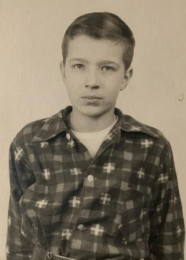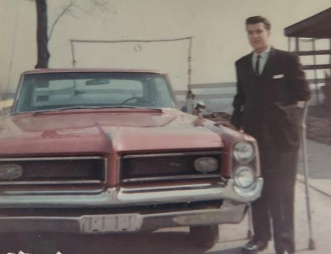John Munsick
One day he was climbing tree. One day later, he was headed for a hospital in an ambulance.
By John Munsick
As this COVID pandemic continues, I have been asked how it compares to the polio epidemic of which I was a victim in 1953. One day I was an active 12-year-old riding my bike, playing baseball with my friends and climbing trees on my grandmother’s farm. The next day, I remember feeling bad, missing school and developing a limp. When my dad got home from work I was taken to a doctor near our home in Clairton, Pennsylvania who sent me to the hospital. The next thing I knew, I was in an ambulance on my way to the Municipal Hospital in Pittsburgh. In our area, cases were sporadic and nothing closed except for some public swimming pools. To my knowledge, I was the only one in my school that was affected by the virus.
After a spinal tap confirmed that I had contacted polio, I was admitted to the hospital and placed in quarantine for about three weeks. My Mother and Dad stood outside my door in robes and masks, unable to come into the room. My back and legs were the most affected. No one told me much and it was a frightening experience to be alone, laying flat on my back and not knowing what was happening.
From the hospital I was sent to The Industrial Home for Crippled Children in the Squirrel Hill section of Pittsburgh for rehabilitation. I was placed in a ward with five other boys, one who had TB, two who were victims of cerebral palsy and a couple of other polio patients. The first step in the recovery process came from a physical therapist who put me through a difficult series of stretching exercises for every muscle affected. The PT was a very painful process of working to and past the point of pain. I went through this ordeal seven days a week. Once a week we were taken to the pool where we could swim. They had a submerged board were Miss Whitfield (the meanest PT in the eyes of a 12 year old) would work you over.
The hospital tried to replicate 7th grade but as I remember, I did not get much from a teacher that came in a few times a week. Other than PT and occasional schooling, there wasn’t much to do. My days were spent listening to the radio. Our highlight was our weekly visits from Mr. Bob Conner, who owned a local hobby shop. I think it was the local Lions Club that paid for the model cars and planes he brought us. My parents were allowed to visit for one hour on Saturday and Sunday. My dad worked Saturday, so my mother would come by bus. She never missed even one day.
I was fitted with uncomfortable splints which I had to wear all day and night. They did loosen some things during the night to make sleep more pleasant. The nurses were great and served us our three meals a day which growing teenagers certainly looked forward to! Speaking of the meals, we were taking in food and given our lack of mobility, we often found ourselves constipated. If a few days went by, one of the nurses would order an enema. Being bedridden made it necessary to use a bedpan. The enemas were really humiliating, but the bedpan was the worst of it. We knew of other wards in the home (such as a baby’s ward and a girls ward) but we were not allowed to visit.
On December 22, 1953, Dr. Franklin Neva (who was part of Jonas Salk’s team), asked my parents to sign a consent form allowing me to take part in a vaccine study at the Industrial Home for Crippled children. The study began in early 1954 and went on for a couple of months.
I remember them coming in and giving a shot and then coming back and drawing blood a day or two later. I remember looking at my arms and noticing all the marks left by needles from the blood draws. My temperature was taken twice a day using the rectal thermometer (certainly not at all pleasant). The vaccine came out in April of 1955. Doctor Salk was not known for acknowledging other members of his team / or efforts that helped in research. The D. T. Watson Home was given credit for polio research but it also happened at the Industrial Home which was nearby to the University of Pittsburgh where Dr. Salk was doing his research.
In the spring of 1954 I was fitted for braces for both legs and then went all the way up my back. In addition, I was given a wheelchair so that I could occasionally leave my bed. I was moved from the ward to what was called “the house” (which was a series of single rooms housing other boys) which gave us independence. We were now going to the dining room for meals instead of being served. We had to navigate a long ramp to get to the dining room. Going down was not a problem as we cut it loose and got to do a circle at the bottom to slow down! Once I lost a wheel and did a tumble, but luckily did not get hurt. Going back up the ramp was definitely harder as it took some muscle power to get to the top.
My braces were made by a man named Si, on site in the brace shop. Si was a polio survivor just like me and he walked with a limp. I was given a pair of forearm crutches (also called Canadian Canes) and the work began with the physical therapists to teach me how to walk with braces and canes. They had me doing steps and I remember going out onto Shady Avenue one spring day to learn curbs and street crossing.
I was finally released to go home. I returned to the 8th grade at Thomas Jefferson Jr. high school. My dad and a neighbor made a ramp that my mother put up on the step of the school bus so I could get on and off. When I got more mobile I was able to do away with using the ramp. The kids welcomed me back and I seemed to fit in. I made a lot of new friends as the school had kids from a lot of different areas. I was very fortunate to have friends who included me in taking part in some of their activities.
I went on to Clairton High school as the new Thomas Jefferson high school was just being completed. After high school I went to Robert Morris School of Business in Pittsburgh where I compiled a certificate in accounting. I rode the bus every day for 3 years to complete it. I worked as an accountant for a short time in a temporary position. In 1962 I was hired by Robert Morris and worked in scheduling students for classes. I was given responsibilities that included building the master schedule and the academic calendar. Robert Morris became a junior college, a four year college and a university offering Master and Doctorate degrees which I can say I was a part of. I retired in 2004 as Registrar after serving for 42 years.
I have been married twice, have four great children and four grandchildren. As I enter my 79th year I have been diagnosed with post polio syndrome which simply stated says I kicked your butt when you were a kid and I’ll kick it again when you are old.
My shoulders and wrists are worn out from using crutches for 65 years. As I look back perhaps I could have saved my upper body by not doing a lot of things but when I think about it I have no regrets.




